



Is it time for your dog to learn some manners? The following pictures and information will help you teach your dog some basic tasks, increase your dog's vocabulary, and create a more trusting bond between you and your best friend. Pick a task below. Also check out the tips at the bottom of the page for making training more enjoyable, and long lasting.
Sit | Down | Stay | Come | Drop It | Up | Off | Shake | Tips
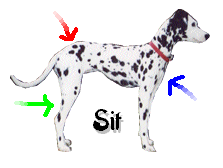
To make your dog sit from a standing position, place your left hand (red) on the dog's chest, and your right hand (blue) on it's tailbone. Push on the chest with your left hand, and push the dog's rear down with your right. While doing this, the back legs (green) should be bending, eventually putting the dog into a sitting position. Remember to say a short, simple command, like "Sit", while doing this. Reward your dog once it sits, and stays in that position for 5 seconds.
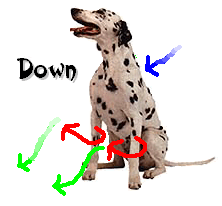
When you start teaching "down", you should always start in the sitting position. Wrap one arm around the dog's body and grasp it's right wrist. Always grab the wrist, not the paw. You will have more control. Use the other hand to grasp it's left wrist. Lift both feet an inch or two off the ground (red) and slide the dog down by pulling it's arms forward (green). Use your left arm to press the dog's body towards the ground while doing this. Remember to use a short, simple command, like "Down." Reward your dog once it lays down, and stays in that position for 5 seconds.
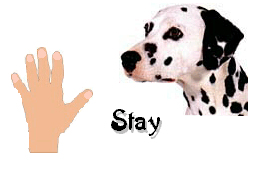
This command is easiest to teach when the dog is sitting, facing you. The trick of this task is to have your dog focus on you, but not get up and follow you. Start out standing directly in front of the dog, and make a "stop sign" with your hand. Put your hand in front of it's nose and say your command, "Stay". Slowly take 1 step back (keeping your hand up), wait 5 seconds (don't put your hand down!), and return to reward your dog. When you step back, stare your dog in the eye, and he will stare you in the eye. It's all about your dog focusing on you. Once your dog has the hang of staying with you 1 step away, gradually increase the number of steps backward you take. Eventually, you should be able to completely leave the room, and return with the dog still sitting there waiting for you to come back.

This command is very simple, and should be taught once the "stay" command is learned. Have your dog sit directly in front of you, and perform the "stay" task, taking 5 steps backwards. With your dog still focusing on you, slowly drop your hand to your side, and say "Come." Your dog will learn this quickly because you are stopping the "stay" command (by dropping your hand) and you are saying a command. When the dog comes to you, and sits directly in front of you, reward it, and eventually increase the space between you and your dog.
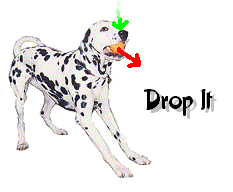
If you dog has something in it's mouth that shouldn't be there, there's a better way of removing it than yanking it out of his mouth (which could pull out teeth and cause more aggressiveness.) First, open the dog mouth and grasp the object, with the other hand, light tap the dog muzzle with your finger. This will not hurt or abuse the dog, but the dog will flinch and let go of the object. Don't actually pull the object, or your dog will just try and pull it back. Use a simple command such as "Drop It". Give the dog a more suitable toy or food item in place for the one you took away from him, and reward him.
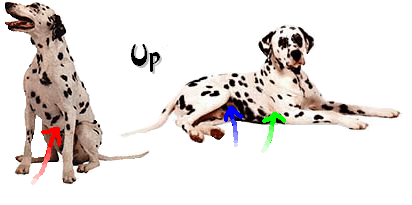
This command is to be used to make your dog stand from a sitting or laying down position. If the dog is down, place one hand under the arm pit, and one under the stomach and lift. If the dog is sitting, place both hands around the hips and pull up. Say your command, "Up" and reward your dog.

Do NOT confuse this command with down. Sometimes, when a dog jumps on the couch, people will say "Down!" But all that does it make the dog LAY down, not GET down. Since your dog doesn't know the different, use the "off" command to get the dog off the couch, or off of your guests. Only teach this command as the occasion arises. Don't tell your dog to get on the couch, only to tell him to get off. Simply push or pull your dog off the couch or person and say "Off", then reward.

This command is always fun to show guests! Start off with a treat in your hand, but keep a fist so your dog can't take it. With your dog sitting in front of you, kneel down and let him sniff your hand. Keep it in front of his nose as he tries to take it out of your hand (don't let him!). Say your command, "Shake" a few times. Soon, he'll start thinking of a different way of getting it out of your hand, so he'll paw at your fist. Once his paw touched your fist, open your hand and let him take the treat. Soon, your dog will always think there's a treat in your hand, and if he paws at it, he'll get it! But since you can't always give it a treat, ALWAYS verbally reward it. This procedure also works with "Wave." If you shake your hand in the air (like waving) with food in it, and your dog paws the air, give it the treat. Soon, he'll learn to do it without food.



Home | Articles & News | Awards | Dal Gallery | Dalmatian Information | Get Our Award | Goodies & Downloads Links & Webrings | Site Info | Spay and Neuter | The Producers | Trivia | Training | Your New Dalmatian


Amyland